Optimizing Agronomic Management Practices for Enhanced Radiation Capture and Improved Radiation Use Efficiency in Winter Wheat
Abstract
:1. Introduction
2. Results
2.1. Tiller Number and Ear-Bearing Tiller Percentage
2.2. LAI and Fraction of Intercepted PAR
2.3. Leaf N, SLN, and NNI
2.4. Intercepted PAR and RUE
2.5. Apparent Photosynthetic Rate of the Canopy
2.6. Aboveground Biomass, Harvest Index, and Grain Yield
2.7. Relative Contributions
2.8. Economic Benefits
3. Discussion
4. Materials and Methods
4.1. Site Description
4.2. Experimental Design
4.3. Sampling and Measurements
4.3.1. Tiller Number and Ear-Bearing Tiller Percentage
4.3.2. LAI, Leaf N, SLN, and Aboveground Biomass
4.3.3. NNI
4.3.4. Intercepted PAR and RUE
4.3.5. Canopy Apparent Photosynthetic Rate
4.3.6. Grain Yield and Harvest Index
4.4. Statistical Analysis
5. Conclusions
Author Contributions
Funding
Data Availability Statement
Conflicts of Interest
References
- Zhang, J.; Wu, T.H.; Dai, X.L.; Wang, X.Z.; Li, H.M.; Jiang, M.Y.; He, M.R. Effects of plant density and nitrogen level on nitrogen uptake and utilization of winter wheat. Acta Ecol. Sin. 2015, 6, 1727–1734. [Google Scholar]
- Zhao, H.L.; Shar, A.G.; Li, S.; Chen, Y.L.; Shi, J.L.; Zhang, X.Y.; Tian, X.H. Effect of straw return mode on soil aggregation and aggregate carbon content in an annual maize-wheat double cropping system. Soil Till. Res. 2018, 175, 178–186. [Google Scholar] [CrossRef]
- Liu, Z.; Gao, J.; Gao, F.; Dong, S.T.; Liu, P.; Zhao, B.; Zhang, J.W. Integrated agronomic practices management improve yield and nitrogen balance in double cropping of winter wheat-summer maize. Field Crops Res. 2018, 221, 196–206. [Google Scholar] [CrossRef]
- Wang, J.; Wang, E.L.; Yang, X.G.; Zhang, F.S.; Yin, H. Increased yield potential of wheat-maize cropping system in the North China Plain by climate change adaptation. Clim. Change 2012, 113, 825–840. [Google Scholar] [CrossRef]
- Guan, D.H.; Zhang, Y.S.; Al-Kaisi, M.M.; Wang, Q.Y.; Zhang, M.C.; Li, Z.H. Tillage practices effect on root distribution and water use efficiency of winter wheat under rain-fed condition in the north China plain. Soil Tillage Res. 2015, 146, 286–295. [Google Scholar] [CrossRef]
- Yin, L.J.; Dai, X.L.; He, M.R. Delayed sowing improves nitrogen utilization efficiency in winter wheat without impacting yield. Field Crops Res. 2018, 221, 90–97. [Google Scholar] [CrossRef]
- Yin, L.J.; Xu, H.C.; Dong, S.X.; Chu, J.P.; Dai, X.L.; He, M.R. Optimised nitrogen allocation favours improvement in canopy photosynthetic nitrogen-use efficiency: Evidence from late-sown winter wheat. Environ. Exp. Bot. 2019, 159, 75–86. [Google Scholar] [CrossRef]
- Dai, X.L.; Zhou, X.H.; Jia, D.Y.; Xiao, L.L.; Kong, H.B.; He, M.R. Managing the seeding rate to improve nitrogen-use efficiency of winter wheat. Field Crops Res. 2013, 154, 100–109. [Google Scholar] [CrossRef]
- Lu, J.S.; Xiang, Y.Z.; Fan, J.L.; Zhang, F.C.; Hu, T.T. Sustainable high grain yield, nitrogen use efficiency and water productivity can be achieved in wheatmaize rotation system by changing irrigation and fertilization strategy. Agric. Water Manag. 2021, 258, 107177. [Google Scholar] [CrossRef]
- Ye, T.Y.; Ma, J.F.; Zhang, P.; Shan, S.; Liu, L.L.; Tang, L.; Cao, W.X.; Liu, B.; Zhu, Y. Interaction effects of irrigation and nitrogen on the coordination between crop water productivity and nitrogen use efficiency in wheat production on the north China plain. Agric. Water Manag. 2022, 271, 107787. [Google Scholar] [CrossRef]
- Chen, X.P.; Cui, Z.L.; Fan, M.S.; Vitousek, P.; Zhao, M.; Ma, W.Q.; Wang, Z.L.; Zhang, W.J.; Yan, X.Y.; Yang, J.C.; et al. Producing more grain with lower environmental costs. Nature 2014, 514, 486–489. [Google Scholar] [CrossRef] [PubMed]
- Cui, Z.L.; Zhang, H.Y.; Chen, X.P.; Zhang, C.C.; Ma, W.Q.; Huang, C.D.; Zhang, W.F.; Mi, G.H.; Miao, Y.X.; Li, X.L.; et al. Pursuing sustainable productivity with millions of smallholder farmers. Nature 2018, 555, 363–366. [Google Scholar] [CrossRef] [PubMed]
- Jin, L.B.; Cui, H.Y.; Li, B.; Zhang, J.W.; Dong, S.T.; Liu, P. Effects of integrated agronomic management practices on yield and nitrogen efficiency of summer maize in North China. Field Crops Res. 2012, 134, 30–35. [Google Scholar] [CrossRef]
- Zhang, H.; Hou, D.P.; Peng, X.L.; Ma, B.J.; Shao, S.M.; Jing, W.J.; Gu, J.F.; Liu, L.J.; Wang, Z.Q.; Liu, Y.Y.; et al. Optimizing integrative cultivation management improves grain quality while increasing yield and nitrogen use efficiency in rice. J. Integr. Agric. 2019, 18, 2716–2731. [Google Scholar] [CrossRef]
- Cheng, Y.; Dai, X.L.; Ren, H.; Wang, Y.C.; Liu, P.; He, M.R. Precision double cropping synergistically improves wheat and maize yields as well as resource efficiency. Agron. J. 2020, 112, 1035–1048. [Google Scholar] [CrossRef]
- Xu, H.C.; Dai, X.L.; Chu, J.P.; Wang, Y.C.; Yin, L.J.; Ma, X.; Dong, S.X.; He, M.R. Integrated management strategy for improving the grain yield and nitrogen-use efficiency of winter wheat. J. Integr. Agric. 2018, 17, 315–327. [Google Scholar] [CrossRef]
- Xu, H.C.; Liu, M.; Tang, Y.H.; Zhao, F.; Cao, W.C.; He, M.R.; Peng, D.L.; Dai, X.L. Optimized management strategy increased grain yield, promoted nitrogen balance, and improved water productivity in winter wheat. Front. Plant Sci. 2023, 14, 1182568. [Google Scholar] [CrossRef]
- Donald, C.M.; Hamblin, J. The biological yield and harvest index of cereals as agronomic and plant breeding criteria. Adv. Agron. 1976, 28, 361–405. [Google Scholar] [CrossRef]
- Rivera-Amado, C.; Trujillo-Negrellos, E.; Molero, G.; Reynolds, M.P.; Sylvester-Bradley, R.; Foulkes, M.J. Optimizing dry-matter partitioning for increased spike growth, grain number and harvest index in spring wheat. Field Crops Res. 2019, 240, 154–167. [Google Scholar] [CrossRef]
- Dai, J.; Bean, B.; Brown, B.; Bruening, W.; Edwards, J.; Flowers, M.; Karow, R.; Lee, C.; Morgan, G.; Ottman, M.; et al. Harvest index and straw yield of five classes of wheat. Biomass Bioenergy 2016, 85, 223–227. [Google Scholar] [CrossRef]
- Porker, K.; Straight, M.; Hunt, J.R. Evaluation of G×E×M interactions to increase harvest index and yield of early sown wheat. Front. Plant Sci. 2020, 11, 994. [Google Scholar] [CrossRef]
- Fischer, R.A. Wheat physiology: A review of recent developments. Crop Pasture Sci. 2011, 62, 95–114. [Google Scholar] [CrossRef]
- Reynolds, M.; Foulkes, J.; Furbank, R.; Griffiths, S.; King, J.; Murchie, E.; Parry, M.; Slafer, G. Achieving yield gains in wheat. Plant Cell Environ. 2012, 35, 1799–1823. [Google Scholar] [CrossRef]
- Aisawi, K.A.B.; Reynolds, M.P.; Singh, R.P.; Foulkes, M.J. The physiological basis of the genetic progress in yield potential of CIMMYT spring wheat cultivars from 1966 to 2009. Crop Sci. 2015, 55, 1749–1764. [Google Scholar] [CrossRef]
- Zhang, Z.; Zhou, X.B.; Chen, Y.H. Effects of irrigation and precision planting patterns on photosynthetic product of wheat. Agron. J. 2016, 108, 2322–2328. [Google Scholar] [CrossRef]
- Ehdaie, B.; Waines, J.G. Sowing date and nitrogen rate effects on dry matter and nitrogen partitioning in bread and durum wheat. Field Crops Res. 2001, 73, 47–61. [Google Scholar] [CrossRef]
- Ferrise, R.; Triossi, A.; Stratonovitch, P.; Bindi, M.; Martre, P. Sowing date and nitrogen fertilisation effects on dry matter and nitrogen dynamics for durum wheat: An experimental and simulation study. Field Crops Res. 2010, 117, 245–257. [Google Scholar] [CrossRef]
- Shah, F.; Coulter, J.A.; Ye, C.; Wu, W. Yield penalty due to delayed sowing of winter wheat and the mitigatory role of increased seeding rate. Eur. J. Agron. 2020, 119, 126120. [Google Scholar] [CrossRef]
- Bavec, M.; Vuković, K.; Mlakar, S.G.; Rozman, Č.; Bavec, F. Leaf area index in winter wheat: Response on seed rate and nitrogen application by different varieties. J. Cent. Eur. Agric. 2007, 8, 337–342. [Google Scholar] [CrossRef]
- Tao, Z.Q.; Wang, D.M.; Ma, S.K.; Yang, S.S.; Zhao, G.C.; Chang, X.H. Light interception and radiation use efficiency response to tridimensional uniform sowing in winter wheat. J. Integr. Agric. 2018, 17, 566–578. [Google Scholar] [CrossRef]
- Dai, X.L.; Wang, Y.C.; Dong, X.C.; Qian, T.F.; Yin, L.J.; Dong, S.X.; Chu, J.P.; He, M.R. Delayed sowing can increase lodging resistance while maintaining grain yield and nitrogen use efficiency in winter wheat. Crop J. 2017, 5, 541–552. [Google Scholar] [CrossRef]
- Gastal, F.; Nelson, C.J. Nitrogen use within the growing leaf blade of tall fescue. Plant Physiol. 1994, 105, 191–197. [Google Scholar] [CrossRef] [PubMed]
- Colnenne, C.; Meynard, J.M.; Roche, R.; Reau, R. Effects of nitrogen deficiencies on autumnal growth of oilseed rape. Eur. J. Agron. 2002, 17, 11–28. [Google Scholar] [CrossRef]
- Olesen, J.E.; Jorgensen, L.N.; Mortensen, J.V. Irrigation strategy, nitrogen application and fungicide control in winter wheat on a sandy soil. II. Radiation interception and conversion. J. Agric. Sci. 2000, 134, 13–23. [Google Scholar] [CrossRef]
- Sinclair, T.R.; Horie, T. Leaf nitrogen, photosynthesis, and crop radiation use efficiency: A review. Crop Sci. 1989, 29, 90–98. [Google Scholar] [CrossRef]
- Grindlay, D.J.C. Towards an explanation of crop nitrogen demand based on the optimization of leaf nitrogen per unit leaf area. J. Agric. Sci. 1997, 128, 377–396. [Google Scholar] [CrossRef]
- Hall, A.J.; Connor, D.J.; Sadras, V.O. Radiation-use efficiency of sunflower crops: Effects of specific leaf nitrogen and ontogeny. Field Crops Res. 1995, 41, 65–77. [Google Scholar] [CrossRef]
- Massignam, A.M.; Chapman, S.C.; Hammer, G.L.; Fukai, S. Physiological determinants of maize and sunflower grain yield as affected by nitrogen supply. Field Crops Res. 2009, 113, 256–267. [Google Scholar] [CrossRef]
- Ravier, C.; Meynard, J.M.; Cohan, J.P.; Gate, P.; Jeuffroy, M.H. Early nitrogen deficiencies favor high yield, grain protein content and N use efficiency in wheat. Eur. J. Agron. 2017, 89, 16–24. [Google Scholar] [CrossRef]
- Giunta, F.; Motzo, R.; Nemeh, A.; Bassu, S. Changes in radiation capture and use in response to the nitrogen status of durum wheat cultivars at different developmental stages. Field Crops Res. 2023, 297, 108947. [Google Scholar] [CrossRef]
- Masoni, A.; Ercoli, L.; Mariotti, M.; Arduini, I. Post-anthesis accumulation and remobilization of dry matter, nitrogen and phosphorus in durum wheat as affected by soil type. Eur. J. Agron. 2007, 26, 179–186. [Google Scholar] [CrossRef]
- Dordas, C. Variation in dry matter and nitrogen accumulation and remobilization in barley as affected by fertilization, cultivar, and source-sink relations. Eur. J. Agron. 2012, 37, 31–42. [Google Scholar] [CrossRef]
- Zhang, Z.Z.; Cheng, S.; Fan, P.; Zhou, N.B.; Xing, Z.P.; Hu, Y.J.; Xu, F.F.; Guo, B.W.; Wei, H.Y.; Zhang, H.C. Effects of sowing date and ecological points on yield and the temperature and radiation resources of semi-winter wheat. J. Integr. Agric. 2023, 22, 1366–1380. [Google Scholar] [CrossRef]
- Zhang, X.Q.; Du, S.Z.; Xu, Y.J.; Cao, C.F.; Chen, H. Reducing N application by increasing plant density based on evaluation of root, photosynthesis, N accumulation and yield of wheat. Agronomy 2021, 11, 1080. [Google Scholar] [CrossRef]
- Fletcher, A.L.; Johnstone, P.R.; Chakwizira, E.; Brown, H.E. Radiation capture and radiation use efficiency in response to N supply for crop species with contrasting canopies. Field Crops Res. 2013, 150, 126–134. [Google Scholar] [CrossRef]
- Lemaire, G.; Jeuffroy, M.H.; Gastal, F. Diagnosis tool for plant and crop N status in vegetative stage: Theory and practices for crop N management. Eur. J. Agron. 2008, 28, 614–624. [Google Scholar] [CrossRef]
- Lemaire, G.; Gastal, F. N uptake and distribution in plant canopies. In Diagnosis of the Nitrogen Status in Crops; Springer: Berlin/Heidelberg, Germany, 1997; pp. 3–43. [Google Scholar]
- Olesen, J.E.; Berntsen, J.; Hansen, E.M.; Petersen, B.M.; Petersen, J. Crop nitrogen demand and canopy area expansion in winter wheat during vegetative growth. Eur. J. Agron. 2002, 16, 279–294. [Google Scholar] [CrossRef]
- Barraclough, P.B.; Lopez-Bellido, R.; Hawkesford, M.J. Genotypic variation in the uptake, partitioning and remobilisation of nitrogen during grain-filling in wheat. Field Crops Res. 2014, 156, 242–248. [Google Scholar] [CrossRef]
- Zhao, B.; Niu, X.L.; Ata-Ul-Karim, S.T.; Wang, L.G.; Duan, A.W.; Liu, Z.D.; Lemaire, G. Determination of the post-anthesis nitrogen status using ear critical nitrogen dilution curve and its implications for nitrogen management in maize and wheat. Eur. J. Agron. 2020, 113, 125967. [Google Scholar] [CrossRef]
- Giunta, F.; Motzo, R.; Nemeh, A.; Pruneddu, G. Durum wheat cultivars grown in Mediterranean environments can combine high grain nitrogen content with high grain yield. Eur. J. Agron. 2022, 136, 126512. [Google Scholar] [CrossRef]
- Li, S.J.; Chen, X.X.; Wang, Z.K.; Wu, D.X.; Wang, M.; Müeller, T.; Zou, C.Q.; Chen, X.P.; Zhang, W. Phosphorus fertilizer management for high yields in intensive winter wheat-summer maize rotation system: Integrating phosphorus budget and soil available phosphorus. Field Crops Res. 2024, 313, 109410. [Google Scholar] [CrossRef]
- Yan, X.J.; Chen, X.H.; Tou, C.Y.; Luo, Z.W.; Ma, C.C.; Huang, W.Q.; Cui, Z.L.; Chen, X.P.; Wu, L.Q.; Zhang, F.S. Exploring phosphorus fertiliser management in wheat production. Eur. J. Agron. 2024, 153, 127063. [Google Scholar] [CrossRef]
- Blackwell, M.; Darch, T.; Haslam, R. Phosphorus use efficiency and fertilizers: Future opportunities for improvements. Front. Agric. Sci. Eng. 2019, 6, 332–340. [Google Scholar] [CrossRef]
- Bremner, J.M.; Tabatabai, M.A. Use of an ammonia electrode for determination of ammonium in kjeldahl analysis of soils. Commun. Soil Sci. Plant Anal. 1972, 3, 159–165. [Google Scholar] [CrossRef]
- Justes, E.; Mary, B.; Meynard, J.M.; Machet, J.M.; Huché-Thélier, L. Determination of a critical nitrogen dilution curve for winter wheat crops. Ann. Bot. 1994, 74, 397–407. [Google Scholar] [CrossRef]
- Sandaña, P.; Ramírez, M.; Pinochet, D. Radiation interception and radiation use efficiency of wheat and pea under different P availabilities. Field Crops Res. 2012, 127, 44–50. [Google Scholar] [CrossRef]
- Acreche, M.M.; Briceño-Félix, G.; Martín Sánchez, J.A.; Slafer, G.A. Radiation interception and use efficiency as affected by breeding in Mediterranean wheat. Field Crops Res. 2009, 110, 91–97. [Google Scholar] [CrossRef]
- Sinclair, T.R.; Muchow, R.C. Radiation use efficiency. Adv. Agron. 1999, 65, 215–265. [Google Scholar] [CrossRef]
- Garrity, D.P.; Sullivan, C.Y.; Watts, D.G. Rapidly determining sorghum canopy photosynthetic rates with a mobile field chamber. Agron. J. 1984, 76, 163–165. [Google Scholar] [CrossRef]
- Zhang, X.; Hua, Y.F.; Liu, Y.J.; He, M.R.; Ju, Z.C.; Dai, X.L. Wide belt sowing improves the grain yield of bread wheat by maintaining grain weight at the backdrop of increases in spike number. Front. Plant Sci. 2022, 13, 992772. [Google Scholar] [CrossRef]
- Chen, M.Z.; Zhang, Y.L.; Liang, F.B.; Tang, J.Y.; Ma, P.C.; Tian, J.S.; Jiang, C.D.; Zhang, W.F. The net photosynthetic rate of the cotton boll-leaf system determines boll weight under various plant densities. Eur. J. Agron. 2021, 125, 126251. [Google Scholar] [CrossRef]

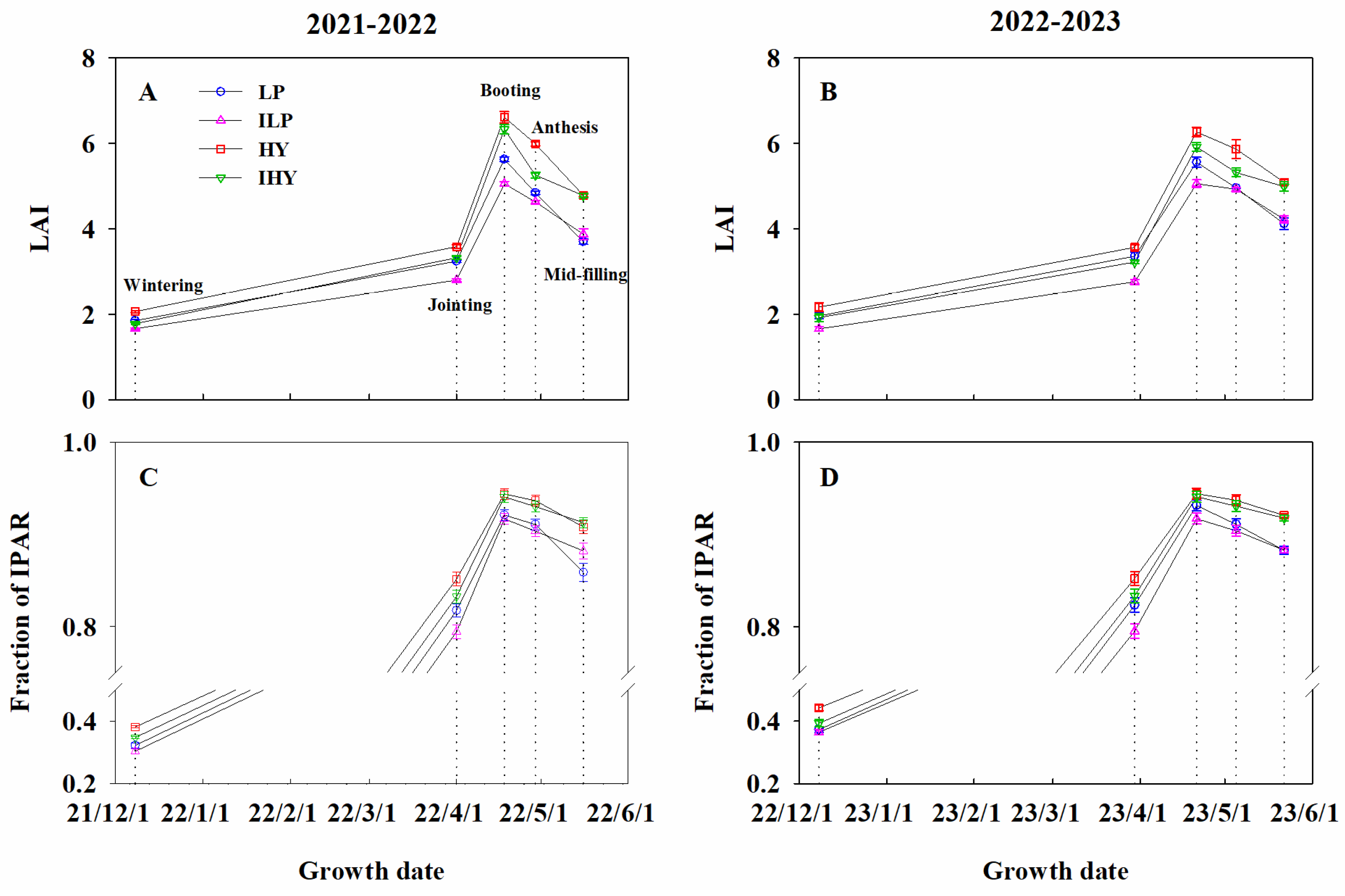
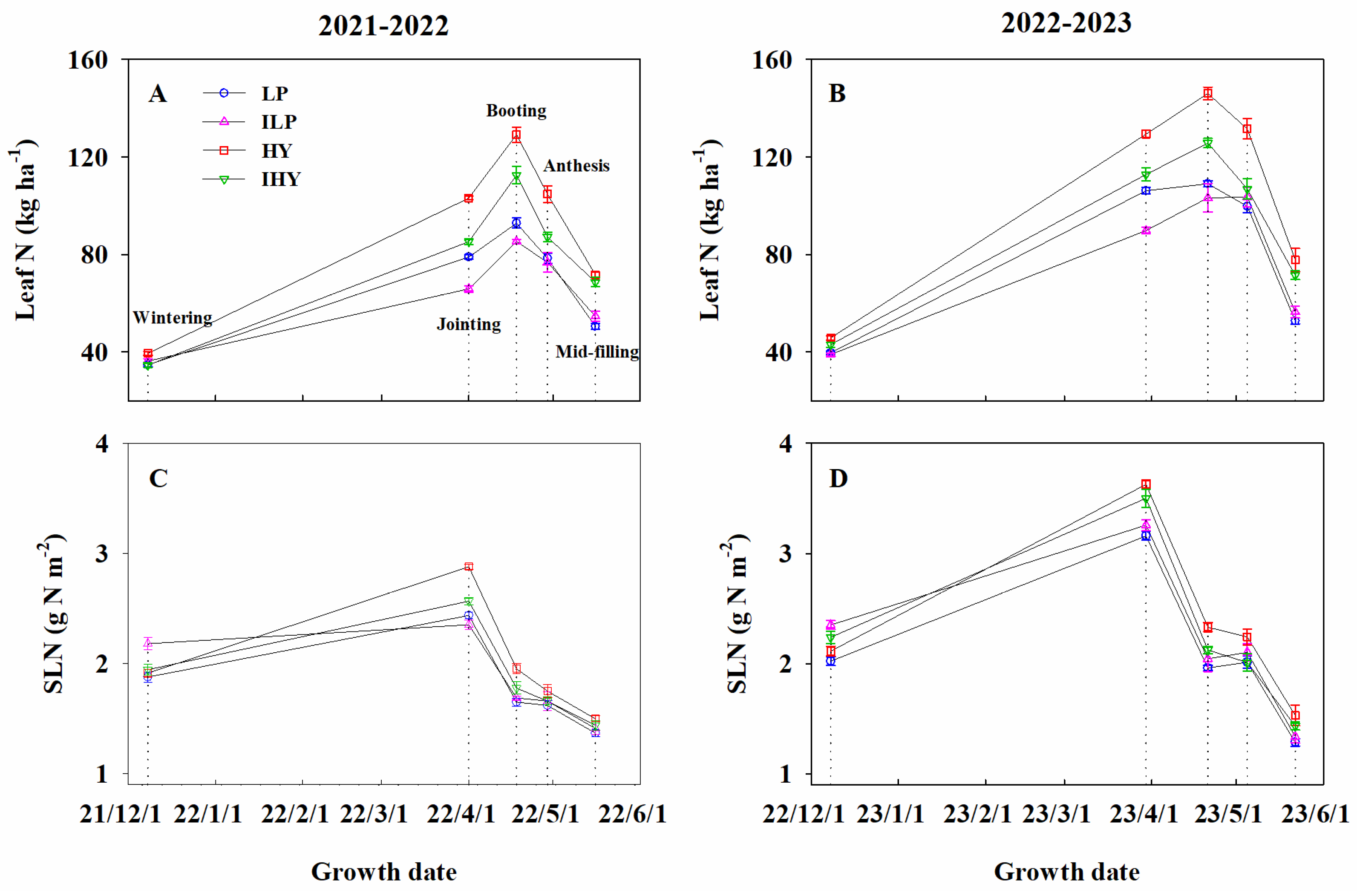

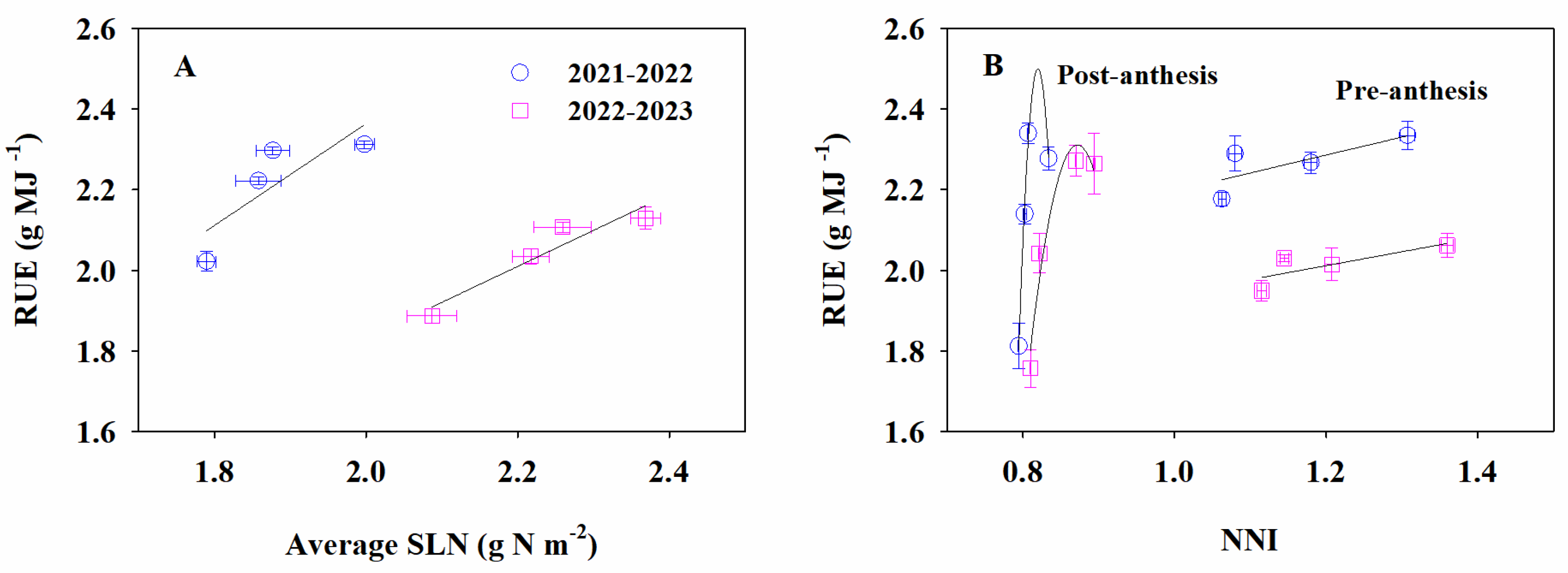

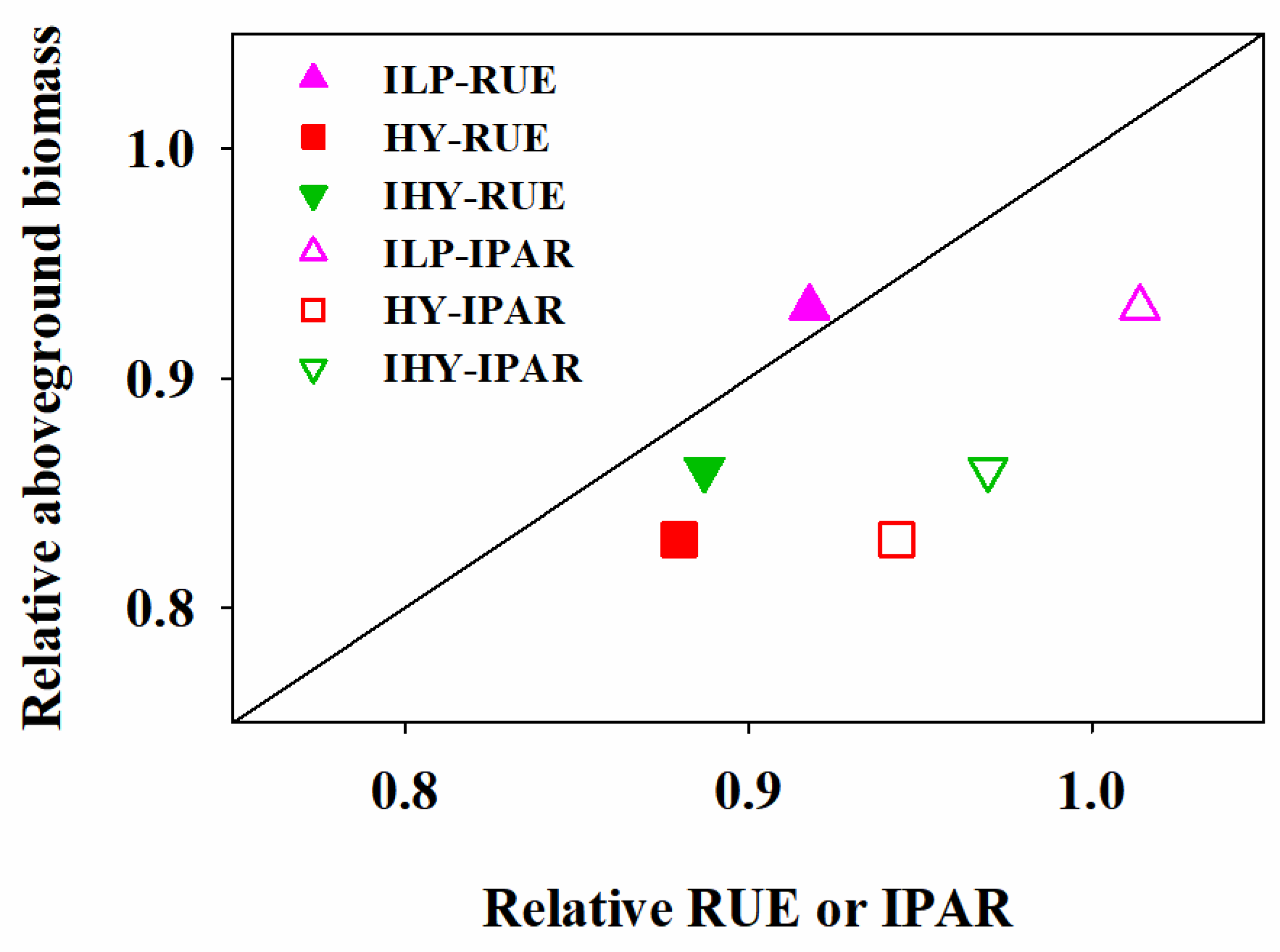
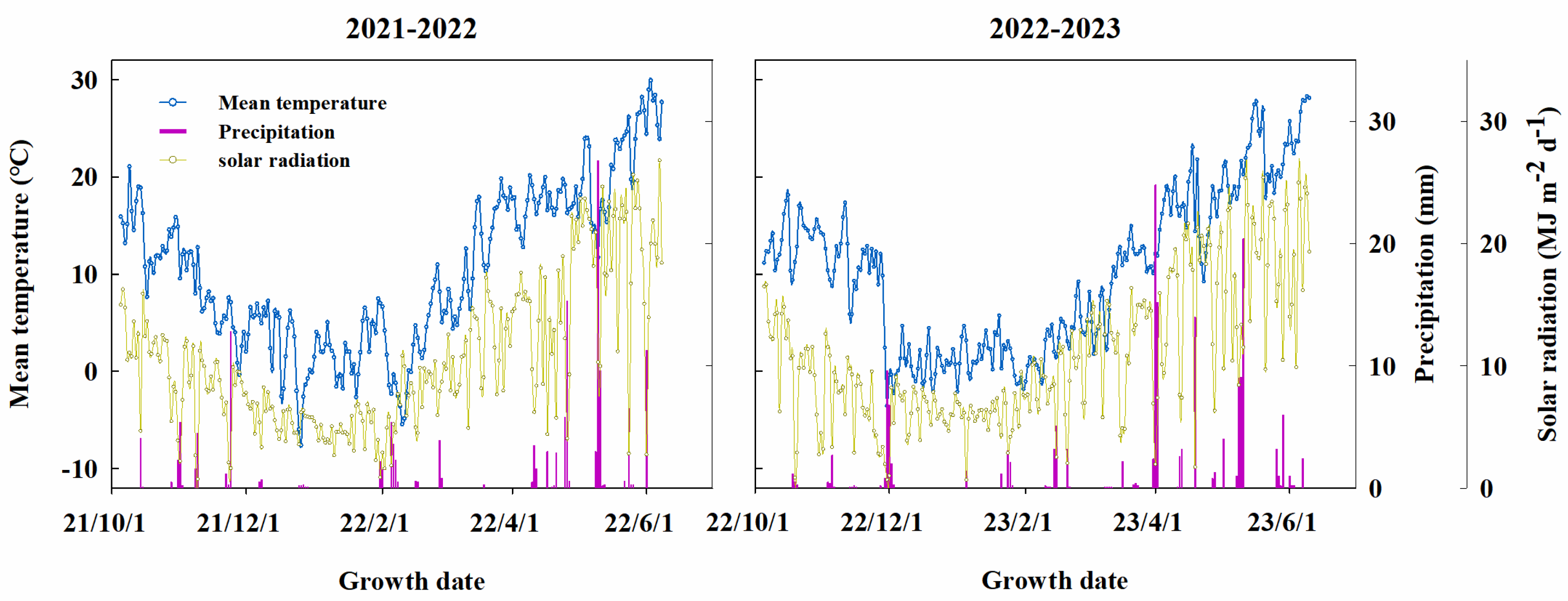
| Year | Treatment (1) | Pre-Anthesis | Post-Anthesis | Whole Growth Stage | |||
|---|---|---|---|---|---|---|---|
| IPAR (MJ m−2) | RUE (g MJ−1) | IPAR (MJ m−2) | RUE (g MJ−1) | IPAR (MJ m−2) | RUE (g MJ−1) | ||
| 2021–2022 | LP | 446.06 b | 2.18 c | 330.01 c | 1.81 d | 776.07 c | 2.02 c |
| ILP | 427.69 c | 2.29 b | 337.94 b | 2.14 c | 765.63 d | 2.22 b | |
| HY | 472.47 a | 2.34 a | 350.62 a | 2.28 b | 823.08 a | 2.31 a | |
| IHY | 451.23 b | 2.27 b | 353.28 a | 2.34 a | 804.51 b | 2.30 a | |
| 2022–2023 | LP | 573.50 b | 1.95 c | 283.58 c | 1.76 c | 857.08 c | 1.89 c |
| ILP | 552.83 c | 2.03 b | 292.22 b | 2.04 b | 845.05 d | 2.03 b | |
| HY | 603.21 a | 2.06 a | 304.97 a | 2.27 a | 908.18 a | 2.13 a | |
| IHY | 573.10 b | 2.01 b | 306.43 a | 2.28 a | 879.54 b | 2.11 a | |
| p-value | |||||||
| Year (Y) | 0.0001 | 0.0001 | 0.0001 | 0.0016 | 0.0001 | 0.0001 | |
| Treatment (T) | 0.0001 | 0.0001 | 0.0001 | 0.0001 | 0.0001 | 0.0001 | |
| Y × T | 0.5072 | 0.5076 | 0.9430 | 0.3422 | 0.0017 | 0.0146 | |
| Year | Treatment (1) | Aboveground Biomass (kg ha−1) | Harvest Index | Grain Yield (kg ha−1) | ||
|---|---|---|---|---|---|---|
| Pre-Anthesis | Post-Anthesis | At Maturity | ||||
| 2021–2022 | LP | 9705.18 c | 5984.21 d | 15,689.39 d | 0.46 b | 7295.24 d |
| ILP | 9785.65 c | 7234.35 c | 17,020.00 c | 0.49 a | 8357.35 c | |
| HY | 11,033.17 a | 7985.08 b | 19,018.25 a | 0.49 a | 9409.29 a | |
| IHY | 10,229.71 b | 8262.07 a | 18,491.78 b | 0.49 a | 9010.58 b | |
| 2022–2023 | LP | 11,169.64 c | 4986.64 c | 16,156.29 d | 0.46 b | 7418.22 d |
| ILP | 11,224.76 c | 5964.68 b | 17,189.43 c | 0.49 a | 8485.64 c | |
| HY | 12,439.87 a | 6908.11 a | 19,347.98 a | 0.49 a | 9489.69 a | |
| IHY | 11,544.28 b | 6975.12 a | 18,519.40 b | 0.49 a | 9086.09 b | |
| p-value | ||||||
| Year (Y) | 0.0001 | 0.0001 | 0.0001 | 0.3070 | 0.0004 | |
| Treatment (T) | 0.0001 | 0.0001 | 0.0001 | 0.0001 | 0.0001 | |
| Y × T | 0.7745 | 0.1493 | 0.0320 | 0.1354 | 0.8159 | |
| Treatment (1) | Input (CNY) | Output (CNY) | Net Profit (CNY) | ||||||
|---|---|---|---|---|---|---|---|---|---|
| Fertilizers | Seeds | Irrigation | Mechanical Operation | Pesticide | Labor | Total | |||
| LP | 3160.27 | 450.00 | 600.00 | 3300.00 | 450.00 | 6000.00 | 13,960.27 | 18,391.82 | 4431.55 |
| ILP | 2576.49 | 600.00 | 600.00 | 3300.00 | 450.00 | 6000.00 | 13,526.49 | 21,053.73 | 7527.24 |
| HY | 4808.97 | 750.00 | 600.00 | 3300.00 | 450.00 | 6000.00 | 15,908.97 | 23,623.72 | 7714.76 |
| IHY | 3027.80 | 900.00 | 600.00 | 3300.00 | 450.00 | 6000.00 | 14,277.80 | 22,620.85 | 8343.05 |
| Treatment (1) | Sowing Date (m/d) | Plant Density (Seeds m−2) | The Stage and Amount of Fertilizer Application (kg ha−1) | |||
|---|---|---|---|---|---|---|
| Fertilizer | Before Seeding | Regreening | Jointing | |||
| LP | 10/5 | 225 | N | 189 | 126 | – |
| P2O5 | 120 | – | – | |||
| K2O | 30 | – | – | |||
| ILP | 10/10 | 300 | N | 105 | – | 105 |
| P2O5 | 90 | – | – | |||
| K2O | 75 | – | – | |||
| HY | 10/10 | 375 | N | 126 | – | 189 |
| P2O5 | 210 | – | – | |||
| K2O | 90 | – | 60 | |||
| IHY | 10/15 | 450 | N | 96 | – | 144 |
| P2O5 | 120 | – | – | |||
| K2O | 45 | – | 30 | |||
Disclaimer/Publisher’s Note: The statements, opinions and data contained in all publications are solely those of the individual author(s) and contributor(s) and not of MDPI and/or the editor(s). MDPI and/or the editor(s) disclaim responsibility for any injury to people or property resulting from any ideas, methods, instructions or products referred to in the content. |
© 2024 by the authors. Licensee MDPI, Basel, Switzerland. This article is an open access article distributed under the terms and conditions of the Creative Commons Attribution (CC BY) license (https://creativecommons.org/licenses/by/4.0/).
Share and Cite
Xu, H.; Liu, M.; Li, C.; Tang, Y.; Xue, Q.; Xiao, W.; Gao, D.; Peng, D.; Dai, X. Optimizing Agronomic Management Practices for Enhanced Radiation Capture and Improved Radiation Use Efficiency in Winter Wheat. Plants 2024, 13, 2036. https://doi.org/10.3390/plants13152036
Xu H, Liu M, Li C, Tang Y, Xue Q, Xiao W, Gao D, Peng D, Dai X. Optimizing Agronomic Management Practices for Enhanced Radiation Capture and Improved Radiation Use Efficiency in Winter Wheat. Plants. 2024; 13(15):2036. https://doi.org/10.3390/plants13152036
Chicago/Turabian StyleXu, Haicheng, Mei Liu, Chuanxing Li, Yuhai Tang, Qiqin Xue, Wanli Xiao, Dongyao Gao, Dianliang Peng, and Xinglong Dai. 2024. "Optimizing Agronomic Management Practices for Enhanced Radiation Capture and Improved Radiation Use Efficiency in Winter Wheat" Plants 13, no. 15: 2036. https://doi.org/10.3390/plants13152036




